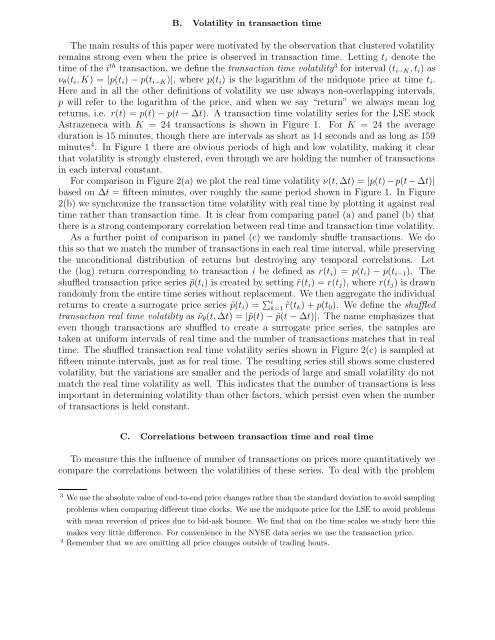There's more to volatility than volume - Santa Fe Institute
There's more to volatility than volume - Santa Fe Institute
There's more to volatility than volume - Santa Fe Institute
You also want an ePaper? Increase the reach of your titles
YUMPU automatically turns print PDFs into web optimized ePapers that Google loves.
B. Volatility in transaction time<br />
The main results of this paper were motivated by the observation that clustered <strong>volatility</strong><br />
remains strong even when the price is observed in transaction time. Letting t i denote the<br />
time of the i th transaction, we define the transaction time <strong>volatility</strong> 3 for interval (t i−K , t i ) as<br />
ν θ (t i , K) = |p(t i ) − p(t i−K )|, where p(t i ) is the logarithm of the midquote price at time t i .<br />
Here and in all the other definitions of <strong>volatility</strong> we use always non-overlapping intervals,<br />
p will refer <strong>to</strong> the logarithm of the price, and when we say “return” we always mean log<br />
returns, i.e. r(t) = p(t) − p(t − ∆t). A transaction time <strong>volatility</strong> series for the LSE s<strong>to</strong>ck<br />
Astrazeneca with K = 24 transactions is shown in Figure 1. For K = 24 the average<br />
duration is 15 minutes, though there are intervals as short as 14 seconds and as long as 159<br />
minutes 4 . In Figure 1 there are obvious periods of high and low <strong>volatility</strong>, making it clear<br />
that <strong>volatility</strong> is strongly clustered, even through we are holding the number of transactions<br />
in each interval constant.<br />
For comparison in Figure 2(a) we plot the real time <strong>volatility</strong> ν(t, ∆t) = |p(t) − p(t − ∆t)|<br />
based on ∆t = fifteen minutes, over roughly the same period shown in Figure 1. In Figure<br />
2(b) we synchronize the transaction time <strong>volatility</strong> with real time by plotting it against real<br />
time rather <strong>than</strong> transaction time. It is clear from comparing panel (a) and panel (b) that<br />
there is a strong contemporary correlation between real time and transaction time <strong>volatility</strong>.<br />
As a further point of comparison in panel (c) we randomly shuffle transactions. We do<br />
this so that we match the number of transactions in each real time interval, while preserving<br />
the unconditional distribution of returns but destroying any temporal correlations. Let<br />
the (log) return corresponding <strong>to</strong> transaction i be defined as r(t i ) = p(t i ) − p(t i−1 ). The<br />
shuffled transaction price series ˜p(t i ) is created by setting ˜r(t i ) = r(t j ), where r(t j ) is drawn<br />
randomly from the entire time series without replacement. We then aggregate the individual<br />
returns <strong>to</strong> create a surrogate price series ˜p(t i ) = ∑ i<br />
k=1 ˜r(t k ) + p(t 0 ). We define the shuffled<br />
transaction real time <strong>volatility</strong> as ˜ν θ (t, ∆t) = |˜p(t) − ˜p(t − ∆t)|. The name emphasizes that<br />
even though transactions are shuffled <strong>to</strong> create a surrogate price series, the samples are<br />
taken at uniform intervals of real time and the number of transactions matches that in real<br />
time. The shuffled transaction real time <strong>volatility</strong> series shown in Figure 2(c) is sampled at<br />
fifteen minute intervals, just as for real time. The resulting series still shows some clustered<br />
<strong>volatility</strong>, but the variations are smaller and the periods of large and small <strong>volatility</strong> do not<br />
match the real time <strong>volatility</strong> as well. This indicates that the number of transactions is less<br />
important in determining <strong>volatility</strong> <strong>than</strong> other fac<strong>to</strong>rs, which persist even when the number<br />
of transactions is held constant.<br />
C. Correlations between transaction time and real time<br />
To measure this the influence of number of transactions on prices <strong>more</strong> quantitatively we<br />
compare the correlations between the volatilities of these series. To deal with the problem<br />
3 We use the absolute value of end-<strong>to</strong>-end price changes rather <strong>than</strong> the standard deviation <strong>to</strong> avoid sampling<br />
problems when comparing different time clocks. We use the midquote price for the LSE <strong>to</strong> avoid problems<br />
with mean reversion of prices due <strong>to</strong> bid-ask bounce. We find that on the time scales we study here this<br />
makes very little difference. For convenience in the NYSE data series we use the transaction price.<br />
4 Remember that we are omitting all price changes outside of trading hours.
















